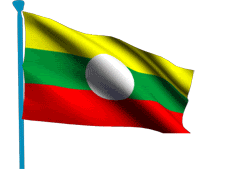The Tai-Turungs
The Tai-Turungs:
Migration of different groups of people through centuries has made Assam one of India’s most multi-lingual, multi-cultural, multi-religious and multi-ethnic states.
Among these ethnic groups are the Turungs, a small community with a distinct tradition, culture and social life. Mainly followers of Buddhism, they entered Assam in early part of 19 century. Turung villages such as Pahukatiya, Pathargaon, Basapathar, Rajapukhuri Turung Gaon and Balipathar are scattered across Golaghat, Jorhat and Karbi Anglong districts of Assam.
The Turungs are believed to be one of the subgroups of Tai, a community known by various names in different part of Southeast Asia – Shan in Burma, Siamese in Thailand, Lao in Laos, Pai in Yunnan so on. The Tai subgroups also have different local names in different regions. For instance, the Shans of Burma are called Htai, Moi, Muong, Tho, Tai-long, Tai-noi, Tai-mao, Tai-no, Pu-tai, Pu-nong, Hei, etc. The Tai groups inhabiting Northeast India are likewise known by their local names, such as Ahom, Nora, Phakiyal, Aitoniya, Khamti, Khamyang and Turung.( Gogoi -1989)
The migration history of the Tai, largely because of Chinese pressure, is said to have begun in the late 5 and early 6 centuries from Southwest China, particularly Yunnan. Irish linguistic scholar GA Grierson said: “A great wave of Tai migration descended in the 6 century from the mountains of Southern Yunnan into the Nam Mau or Shweli Valley and the adjacent regions.” LW Shakespear, in his book History of Upper Assam, Upper Burma and the North-East Frontier wrote: “The Tai people gradually consolidated a strong kingdom between the upper Irrawaddy and upper Chindwin, known in early time as Pong. But in the long period of time, before the Pong kingdom could make itself felt, the Kachins were increasing in numbers in Hkamti Long and in course of time expanded across the Patkoi range and down Hukong valley, driving the Tai (Shan) people.” Thus, the Tai or Shan groups that migrated to Assam and other part of Northeast India, are believed to be from northern or Upper Burma (Myanmar).
The Tais entered Assam in several waves, the Ahoms being the first group in the early part of the 13 century. Edward Gait stated: “The Khamtis, Phakials, Aitonias, Turungs and Khamjangs are all Shan tribes who have, at different times, moved along the same route... but the Ahoms were the only ones who did so before the conversion of its inhabitants to Buddhism. The other Shan tribes of Assam are all Buddhist, which shows that they migrated at a later date. The Turungs reached the plains of Assam only by the beginning of the 19th century.” The Turungs can thus be said to be the last Tai group to enter Assam.
The history of the Turungs is controversial and highly contested, necessitating further study. There is available literature as well as a Singpho version narrated by Stephen Morey in his recent study.
Grierson said the Turungs came from Mung-Mang Khan-Sang on the northeast of Upper Burma and settled down near the river Turungpani or Turungkha, a small tributary of the Chindwin River in Burma. The Turungs believe they derived their name from Turungpani, but another theory says the river was named after them. Grierson stated: “...they settled on the Turungpani River, which took its name, the Tai Rong Water, from them.”
According to Grierson, the Northern Shans were always spoken of by other branches of the family as Tai Long or ‘Great Tai’. In the Shan language, the letters “l” and “r” are freely interchanged; thus Tai Long becomes Tai Rong. One section of the Shans that entered Assam retained this name, and its members are known as Tairongs, Turangs, or Sham (Shan) Turungs.
While the Turungs living at Turungpani, another Tai group called Nora( who were then living in Ahom kingdom) invited them to Assam and thus the Turungs made their journey towards Assam. But while crossing the Patkoi range, they were detained by the Kachins or Singphos, taken as prisoners and enslaved for several years (Grierson 1904).
But the Turungs do not accept Grierson’s enslavement account. However, the Turungs do accept that they lived in close proximity with the Singphos, but not as slaves. (Morey 2010) The period of their living in proximity is however not clear and is yet to be ascertained.
According to the Administration Reports of Assam, 1892-93 and 1901-02 cited by UN Gohain, the Turungs were made to work as slaves for five years. While Grierson argued they “probably remained (slaves) for a much longer period”, Edward Gait estimated “about 100 years”. Various writings make it evident that the Turungs adopted the Singpho language during this period. Therefore, the language the Turungs speak today is a mixture of Tai and Singpho. Since adopting another community’s language is a time-consuming process, their enslavement could not have been for a short period.
During the first Anglo-Burmese war in 1825, the British army led by Captain Neufville is said to have freed at least 6,000 Assamese captives after raiding the Singphos and the Burmese. The Turungs, supposed to be among them, were brought to the present Jorhat district of Assam. Turung oral history refers to the place as Tokali, about 3km from Jorhat town, from where they spread to other parts of Assam.
The Singphos of eastern Assam and Arunachal Pradesh – divided into four groups, viz. Numhpuk Hkawng, Diyun Hkawng, Tieng Hkawng and Turung Hkawng – have a different take on the Turung history. Some claim the Turungs were originally one of the Singpho clans. “The Singphos believe, therefore, that the Turungs were a group of Singpho speakers who by intermarrying and living with the Tai, particularly Tai Aiton, gradually adopted some features of Tai language,” Morey wrote.
But the Turungs find it hard to accept this.
Original writer: Montu Kumar Daimary (Shared by C.K Tunkhang).




No comments